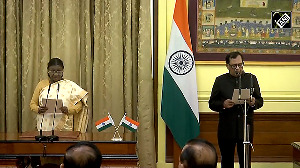India registered a comfortable seven-wicket victory over Australia shortly after tea on the fifth and final day of the second Test at the Chinnaswamy Stadium, in Bangalore, on Wednesday.
The victory helped the hosts pocket the series 2-0 and consolidate their top spot in the rankings.
India had already retained the Border-Gavaskar Trophy by virtue of their victory in the opening Test at Mohali last week.
Chasing 207 to win, the home team easily got to the target, and for the first time made a clean sweep in a series against Australia.
Needing just 22 to win at the start of the final session, India rattled off the runs in quick time (seven overs).
Sachin Tendulkar remained unbeaten on 53 and Rahul Dravid on 21; the duo put together a 61-run stand for the fourth wicket to help India home.
Earlier, India made quick work of the Australian tail. The visitors were dismissed for 223 in their second essay, having batted for 75.2 overs. It took the hosts just 62 balls to take the remaining three Australian wickets.
It was the highest total India had chased successfully in Bangalore -- surpassing the 151 against New Zealand in 1995. It also happened to be the highest target ever chased at the Chinnaswamy stadium, beating Australia's 194 against India in 1998.
For the record, it is India's first win in five attempts over Australia at the Chinnaswamy stadium. The home team had hitherto lost two and drawn two of their previous four matches against the team from Down Under.
The defeat was Australia's fifth in their last seven Tests on Indian soil. The last occasion Australia beat India in their backyard was at Nagpur in October 2004 -- a win that also helped them seal the series.
The result also implied Ricky Ponting's search for a Test win (as captain) continued. Ponting has had to endure five defeats in his seven Tests as captain in India. And the record might stand as it is, as chances are this might be his last tour to India.
The 2-0 series loss also meant Australia will drop to fifth in the ICC Test rankings, their lowest position since inception of the rankings.
Morning session:
Australian (2nd innings): (21 runs, 10.2 overs, 3 wickets)
Australia started cautiously on the fifth and final day. Mitchell Johnson (11) and Nathan Hauritz (21 not out) put on 32 runs for the eighth wicket.
Johnson smashed a Zaheer delivery wide of mid-off to not only ensure a boundary but also stretch the Australian lead to 200.
Then Zaheer, in his fourth over, struck. He cleaned up Johnson to give the home team their first breakthrough for the day.
They didn't have to wait long for the second, Sreesanth rattling Ben Hilfenhaus' (0) stumps in the very next over.
And Zaheer soon had Peter George (0) caught behind to end the Australian innings. The left-arm seamer was India's best bowler with figures of three for 41, his analysis on the fifth day making for impressive reading: 5.2-1-9-2.
Earlier, the visitors resumed from their overnight score of 202 for seven, looking to extend their lead and put themselves in a winning position.
Indian (2nd innings): (73 runs, 12 overs, 1 wicket)
Murali Vijay began the Indian reply on a confident note, steering the first ball (off Hilfenhaus) wide of gully for the first boundary of the innings.
Michael Hussey didn't help the Australian cause much by dropping Virender Sehwag (when on one) at gully in the second over bowled by Johnson.
The let-off didn't prove costly, though.
Hilfenhaus struck in the next over, having Sehwag (7) caught behind. Pujara was promoted up the order to number three. The move worked well.
The introduction of Nathan Hauritz, in the ninth over, didn't help either, the spinner conceding 12 runs in his first over, with Pujara helping himself to two boundaries, both right of mid-off. And in his second over, it was Vijay who singled him out.
After 12 overs (at lunch), the home team had made 73 for one, with Murali Vijay on 29 and giving him company was Cheteshwar Pujara on 28. The duo looked confident and scored at a faster rate, putting together a 56-run partnership for the second wicket in quick time (just 60 balls).
Post-lunch session: (112 runs, 26 overs, 2 wickets)
Watson dismissed Murali Vijay leg before to give Australia a much-required breakthrough soon after lunch. Vijay's 45-ball 37 was inclusive of six boundaries; he put on 72 runs for the second wicket with Pujara (in just 78 balls).
In came Tendulkar, and immediately he started doing what he does best -- attack from the first ball.
Pujara, meanwhile, continued his good work. A boundary between fine-leg and deep-square off Watson helped him get to 48. Two balls later, another pull to the fence helped him reach his maiden Test fifty. Considering he had scored just four in his first Test innings, facing just three balls, it was definitely an occasion to savour.
The Saurashtra batsman became only the fifth Indian to score 50 or more in the fourth innings of a Test on debut. The last to do it was Sunil Gavaskar, in 1971.
Pujara and Tendulkar put together 57 runs for the third wicket to all but seal Australia's fate.
Then Hauritz, who has been listless throughout the series, for once bowled a good delivery that got the better of Pujara's defence.
Pujara's 89-ball 72 was inclusive of seven hits to the fence.
In Hauritz's eighth over, Tendulkar seemed to be in a hurry, hitting successive sixes over long-on. And along with Dravid, he took India to the brink before tea, making the final session a mere formality.
After 38 overs (at tea), the home team had scored 185 for three, with Tendulkar on 39, and giving him company was Dravid on 13.
Needing just 22 to win in the final session, India rattled off the runs in quick time (seven overs).
Tendulkar remained unbeaten on 53 and Dravid on 21; the duo put together a 61-run stand for the fourth wicket as India cruised home.






